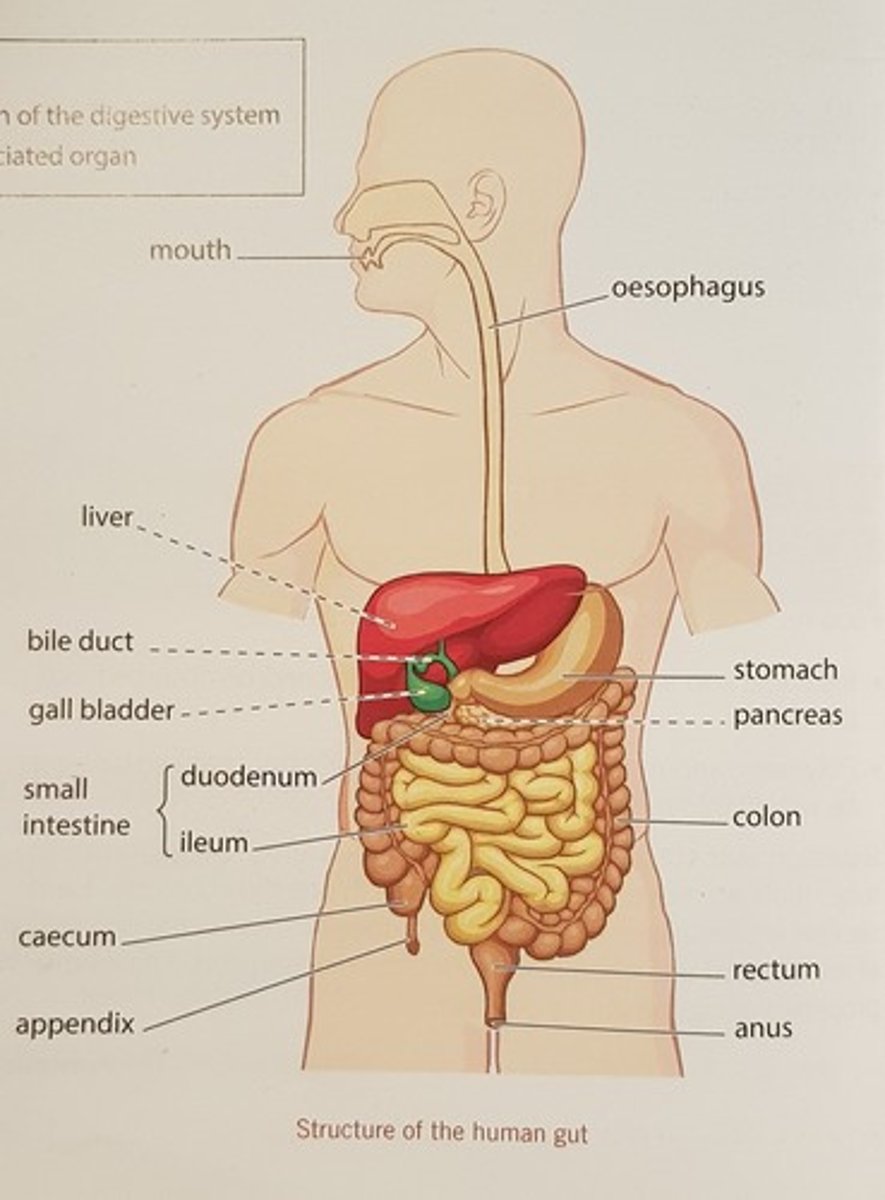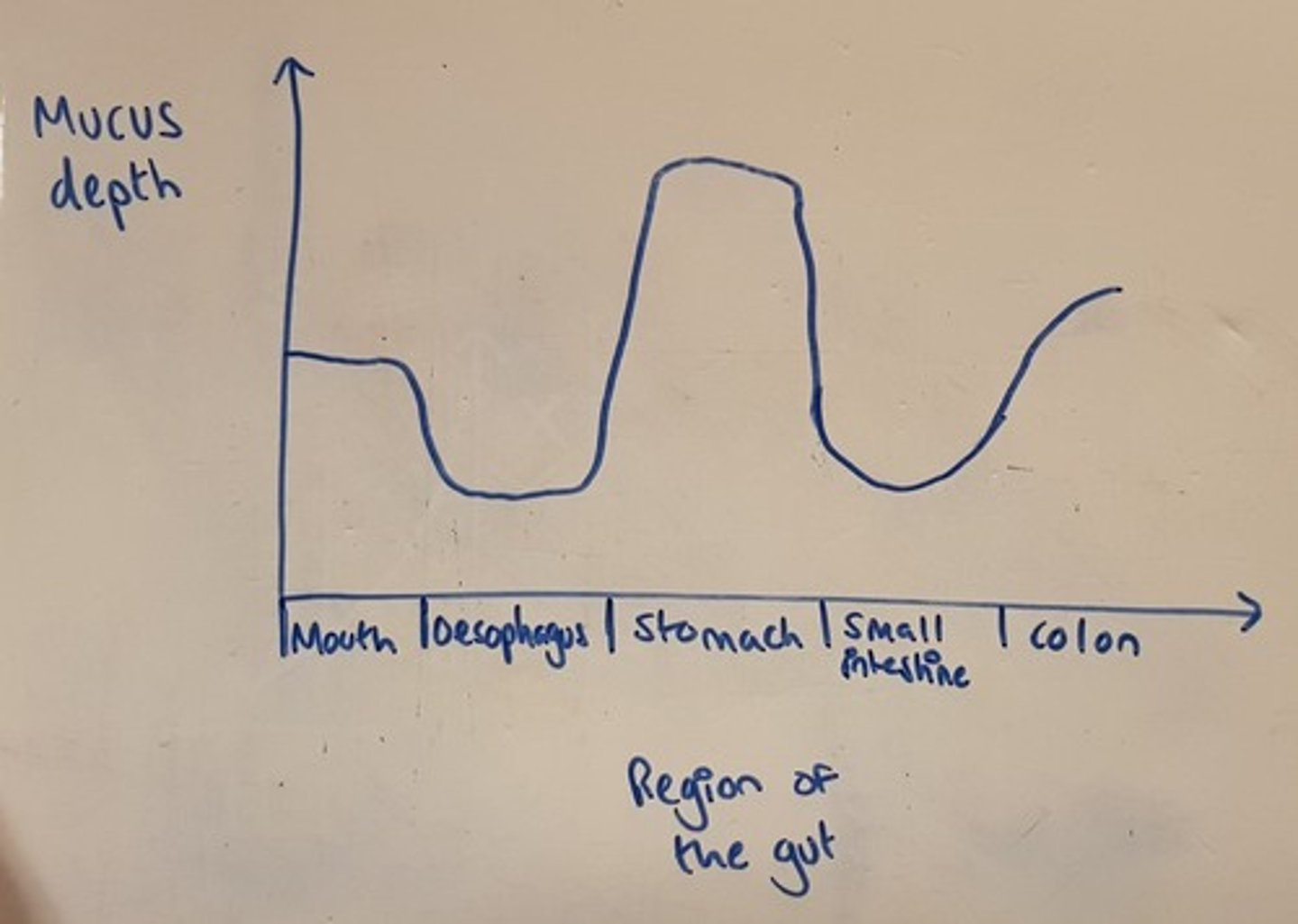Eduqas Biology A Level C3 - Nutrition
1/144
There's no tags or description
Looks like no tags are added yet.
Name | Mastery | Learn | Test | Matching | Spaced |
|---|
No study sessions yet.
145 Terms
Draw a labelled diagram of the digestive system, from mouth to anus

Mechanical digestion definition
Physical breakdown of large pieces of food into smaller pieces
Chemical digestion definition
Process by which enzymes break down large food molecules into smaller molecules that the body can use
What enzyme do the salivary glands produce?
amylase
What molecule does amylase target?
Starch
Starch + Amylase =
maltose
What is maltose?
A disaccharide composed of two alpha-glucose units
What kind of digestion occurs in the mouth?
chemical and mechanical
What molecules are digested in the mouth?
Starch only
Why is mechanical digestion important in the mouth?
Because it increases the surface area of the food particles, and makes food easier to swallow so we don't choke
What is a bolus?
Portion of food swallowed at one time
What part of the body does the bolus pass to after the mouth?
The oesophagus
What is the mouth also known as?
Buccal cavity
How does the oesophagus move the food down towards the stomach?
Peristalsis
What are the 4 layers of the oesophagus wall (from the lumen out)?
Mucosa, Sub-mucosa, Muscularis and Serosa
What is the purpose of the mucosa layer in the oesophagus wall?
It secrets mucus to lubricate the oesophagus
What is the purpose of the sub-mucosa in the oesophagus?
It is connective tissue containing the blood vessels and lymph vessels of the oesophagus, as well as nerves that coordinate peristalsis
What is the purpose of the muscularis layer in the oesophagus?
To contract and relax during peristalsis
What is the purpose of the serosa layer in the oesophagus wall?
It protects the oesophagus wall from friction injuries as it moves during food processing
Peristalsis definition
Rhythmic wave of coordinated muscular contractions in the circular and longitudinal muscle of the gut wall, passing food along the gut in one direction only
What is a sphincter?
A circular muscle that constricts or dilates to regulate the passage of materials through an opening
What controls the entrance and exit of the stomach?
The two sphincters at the entrance and the exit
What is the sphincter at the entrance of the stomach called?
The cardiac sphincter
What is the sphincter at the exit of the stomach called?
The pyloric sphincter
What is the purpose of the mucosa of the stomach?
It secretes mucus and digestive enzymes
What is the purpose of the sub-mucosa in the stomach?
It contains blood vessels, lymph vessels, and the nerves that control peristalsis
What types of digestion occur in the stomach?
chemical and mechanical
What molecules are digested in the stomach?
Proteins only
How is the mucosa of the stomach structured?
It has large folds called rugae
What are the large folds in the mucosa of the stomach wall called?
Rugae
How does the muscular wall of the stomach differ from that in the oesophagus?
The stomach has an extra layer of muscle called oblique muscle, to aid with peristalsis
What are the two muscles found in the muscularis layer of all the gut walls?
Circular muscle and Longitudinal muscle
What is the purpose of the muscularis layer in the stomach wall?
To provide contractions during peristalsis
What is the purpose of the serosa layer in the stomach wall?
To protect the stomach against friction injuries caused by movement during food processing
What is the purpose of mucus in the stomach?
It coats and protects the stomach walls from being damaged and digested by the pepsin and HCl
What is a gastric pit?
Gastric pits are found in depressions of the mucosa, and contain the gastric glands
What do the gastric glands contain?
Gastric juices, consisting of pepsinogen, HCl and pepsin
What cell secrets mucus and where is it found?
Goblet cells, found in gastric pits
What are the two important cell types found in the lining of the gastric pits?
Oxyntic cell and chief cells
What is the purpose of an oxyntic cell?
It secrets HCl
Why is HCl required in the gastric glands of the stomach?
HCl is used to activate pepsinogen and convert it to pepsin
What is the purpose of chief cells?
They secret pepsinogen
What is pepsinogen?
Inactive form of pepsin
How is pepsinogen activated?
With the addition of HCl
Why isn't pepsin produced directly as pepsin in the cells instead of pepsinogen?
Pepsin is a strongly hydrolysing enzyme and would hydrolyse the proteins in the cells of the stomach wall
How does the stomach protect itself against auto-digestion?
Pepsinogen, which is non-hydrolysing, is created in the cells, and is activated outside of the cells in the gastric pits.
What is pepsin?
An endopeptidase
What is an endopeptidase?
Enzyme that hydrolysises a polypeptide chain somewhere in the middle (as opposed to at the terminals)
What is an endopeptidase?
Enzyme that hydrolysises a polypeptide chain at the terminals of the chain (as opposed to somewhere in the middle)
What endopeptidases and exopeptidases are found in the stomach?
Only Pepsin, an endopeptidase, is found in the stomach
How long does food stay in the stomach?
An average of 4-6 hours
Why must the contents leaving the stomach be neutralised?
The enzymes in the rest of the gut do not work well at low pH levels
Draw a graph showing mucus depth in each region of the digestive system (mouth, oesophagus, stomach, small intestine, colon)

Why is the mucus level relatively high in the mouth?
To lubricate the mouth and also aid the mechanical digestion of the food
Why does the mucus level decrease from the mouth to the oesophagus?
The mucus is only required for lubrication, so there is less
Why is the mucus level in the stomach very high?
The mucus aids mechanical digestion, lubricated and protects the stomach lining from the low pH and the hydrolysing enzymes
Why does the mucus level decrease from the stomach to the small intestine?
Less protection is needed, as the low pH has been neutralised. In the ileum of the small intestine absorption is occurring and so a small diffusion pathway is favoured
Why does the mucus level increase from the small intestine to the colon?
Water is being absorbed and so more lubrication is needed
What contents are entering the small intestine from the stomach?
Carbohydrates such as starch and maltose, short polypeptides and lipids
What does the small intestine consist of?
The duodenum and the ileum
Which is first, the duodenum or the ileum?
The duodenum
When does the pancreatic juice enter the digestive system?
At the duodenum
How does the pancreatic juices enter the digestive system?
Via the pancreatic duct
Where is pancreatic juice created?
pancreas
Does any absorption occur in the stomach?
No
Does any absorption occur in the duodenum?
No
Does any absorption occur in the ileum?
Yes
Does digestion occur in the ileum?
No
What is contained in the pancreatic juices?
- Trypsinogen
- Enterokinase
- Lipase
- Amylase
- Sodium Hydrogen Carbonate
- Other endopeptidases
Are there exopeptidases present in the stomach?
No
Are there exopeptidases present in the small intestine?
Yes
What is trypsinogen?
An inactive form of trypsin
What is trypsin?
An endopeptidase
What activates trypsinogen?
enterokinase
What is enterokinase?
An enzyme in the small intestine that activates trypsinogen
What is the purpose of amylase in pancreatic juices?
To hydrolyse any remaining starch into maltose
What is the purpose of lipase in pancreatic juices?
To hydrolyse lipids into fatty acids and glycerol
What is the purpose of sodium hydrogen carbonate in the pancreatic juices?
To neutralise the pH of contents leaving the stomach, to provide a suitable environment for enzyme action
How does the function of the duodenum differ from the function of the ileum?
The duodenum is for digestion, and the ileum is for absorption and the last bit of digestion
Where is bile made?
liver
Where is bile stored?
gallbladder
What are the two purposes of bile?
To neutralise pH, and to emulsify fats
Why is it beneficial for fats to be emulsified by bile?
It increases the surface area for enzyme action of lipase
Where do exopeptidases work?
In the epithelial cells of the small intestine
Where do endopeptidases work?
In the stomach and the duodenum
How is the ileum structured to aid absorption?
- It is very long and its lining is folded, increasing the surface area at which absorption can occur
- The folds in the lining are villi, which also have microvilli, further increasing surface area
- The epithelial cells have many mitochondria to respire and produce ATP for active transport
- There is a good blood supply to maintain a constant concentration gradient
Do exopeptidases work in the stomach, along with endopeptidases?
No, they are only found in the small intestine
How are amino acids absorbed into the blood stream in the digestive system?
They are transported into the epithelial cells by active transport and then are transported into the capillaries via facilitated diffusion
How is glucose absorbed into the blood stream from the digestive system?
Glucose is first transported into the epithelial cells by co-transport with sodium ions, or by active transport. Glucose then moves into the capillaries via active transport or facilitated diffusion (depending on the concentration gradient)
How is glycerol absorbed into the blood stream from the digestive system?
Glycerol diffuses into the epithelial cells (simple diffusion) and then into the lacteals
The lacteals lead into the lymphatic system, and eventually the glycerol will enter the blood at the neck
How are fatty acids absorbed into the blood stream from the digestive system?
Fatty acids diffuse into the epithelial cells (simple diffusion) and then into the lacteals
The lacteals lead into the lymphatic system, and eventually the fatty acids will enter the blood at the neck
How are minerals absorbed into the blood from the digestive system?
simple diffusion, facilitated diffusion and active transport
How are disaccharides absorbed into the blood from the digestive system?
The are actively transported from the gut lumen into the epithelial cells, and then broken down into monosaccharides. As monosaccharides, they enter the blood stream via facilitated diffusion
What happens to the lipids absorbed after digestion?
- Used in membranes
- Used to make some hormones
- Excess is stored
What happens to the glucose absorbed after digestion?
- Taken to body cells and respired for energy
- Stored as glycogen in liver and muscle cells
- Excess is stored as fat
What happens to amino acids absorbed after digestion?
- Taken to body cells for protein synthesis
- Excess is deaminated
- NH₂ groups are converted into urea
- The rest of the amino acids are converted to storage
What are the 4 parts of the large intestine?
ceacum, appendix, colon and the rectum
What is the purpose of the colon?
to absorb water and salts
What two things are absorbed by the colon?
water and dissolved minerals/salts
Define autotroph
An organism that synthesises its own complex organic molecules from simpler molecules using light or chemical energy